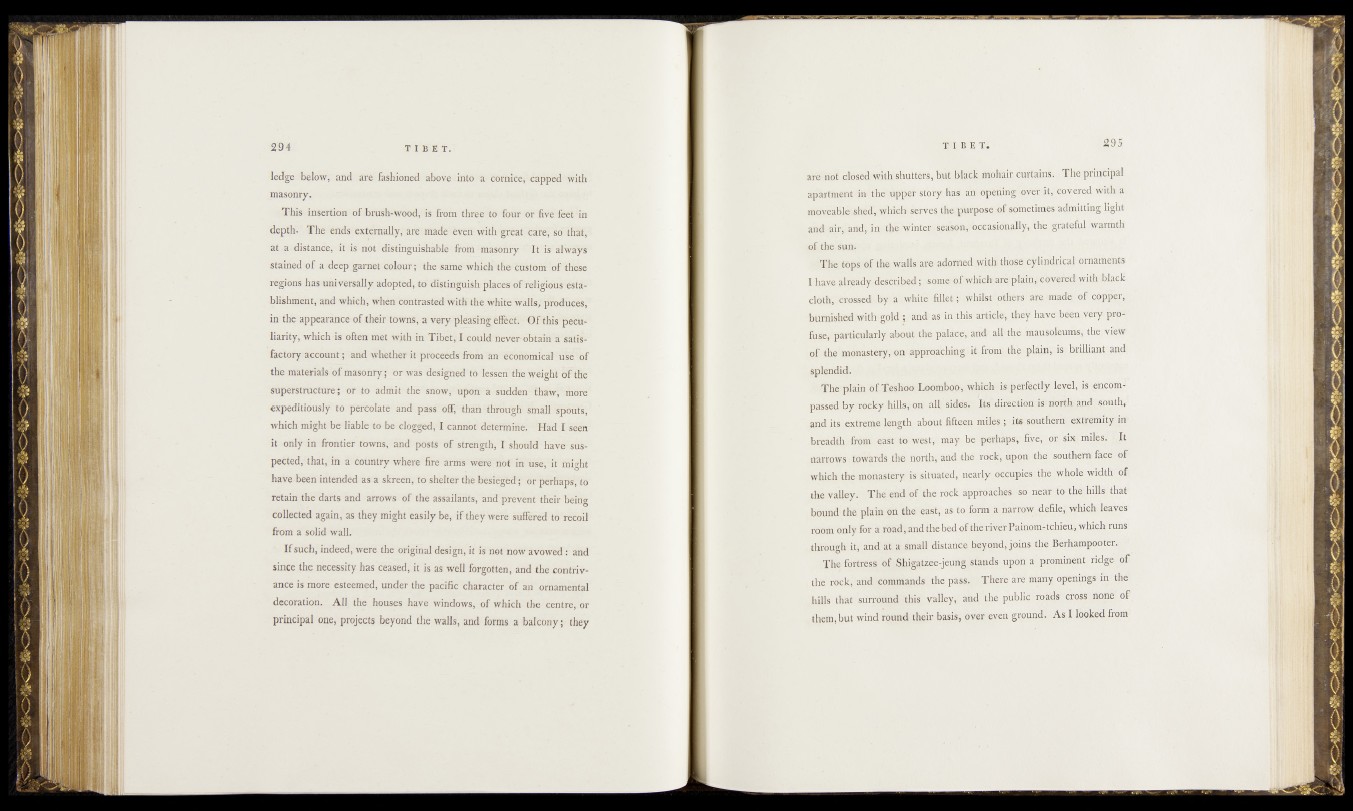
'ledgfösSbelow, and are fashioned above 'into a cornicef- capped with
masonry.
This, insertion of fii^foWood, is from three to four or five feet in
depth. The- ends'- externally, are made even1 with great care, so4ha$,
at .a-distanee,!' i{ :is not distinguishable from masonry
stained óf a deepgaraet colour; the same which the^custom of thÓse
regions has universally adopted, to distinguisfcplacèstóf reKgtó'ós‘ésta-!i
blishment, and which, when contrasted with' the White walls,' produces,
in the appearance of their towns, a very pleasing ëflbfet-.'* Of this peculiarity,
which is often met with in Tibet, I could never obtain'!a satiè-:’
factory account; and whether it proceeds from an èconÖniicÉJ '# e %f
the materials of masonry; or was designed tóïesserf the weig8l'fjPt®igD
superstructure; • or .to admit the snow, upon a sudden {haw? ihore
expeditiously to- percolate and pass off, than through smafl spouts,
which might be liable to be clogged, I cannot determine: Had I seen
It only in frontier towns, and posts of strength, I should hav^sts-
pebted, that, in a country where fire arms wërëriof in Use, it xfii'At'
have been intended as a skreen, to shelter the besiëgëd; or perhaps/to
retain the darts mid arrows of the assailants, and prevent their being
collected again, as they might easily be, if they were suffered to recoil
from a solid wall.
If such, indeed, were the original design, it is net now avowed : and
sincere necessity has ceased, it is as well forgotten, and the contrivance
is more esteemed, under the pacific character of an ornamental
decoration. All the houses have windows, of which the centre, or
principal one, projects beyond the walls, and forms a balcony; they
are noi eli^stfe|Hw4t'%jsl%i]^fs-, b iH> j
apartment SjUSfthi S&fFpci \tbfy1 fi.i'f ara^^penhigipy’d'E ifjl a
gfejafaffi. ythfefagfir,ves Me^pfepoS&‘(tf»1g Aetfeft.eSf a&sffi
andMiiPjiand5, jn^the ^warmth
of the sun. ^
■ "The topSifpf the walls
1 a 1 rp.a dy,d ejtprjb^di
chtth,V^ro'ss,e<fe%;^Wh^^p ; w^stfwtliei*are,»ufiitl^rtf’' copVfi,.
bUrnishedjwithSgold ;P%it’asdn this a rg & l^ h e^ '^ ^ ^ ^ v sfe v prp^
fuse,- particularly^ ab0ut.*tiS^-padagd^^d^^'l'!th.e ?mp,us9| 6u^®||^!yfewi
of''the monastery, «oniJapproaching^iit.fitpnii the-plain,-is^felliant and*
splendid.
The'plain of Tesh|s^I^pttbQ>,;i|}|j% ^^
passed'byTocfcy-hills,-on alb'sidds. It^ili^LKifi'-isSiiorth^arid^
and its. extreme length about fifteen miles ; it^ 's^w e» exterdn^ in»
breadth from east to-,west, may be 'p^hips^^e^IpE- six miles, ^ t
narrows towards the, northjtaiid the rdck®, irpon. '^^'-southe'mlf^cej of
which the monastery is situated, n eari^ d ^ lf^ ith e whole-wld$| oE
the valley. Theiend of the rock ab£r$a%||.so ncai to the^ hi 11®-that-
bound* the plain on the east, as to fqA.ai harrc^W^^lwhich’ leaves1
room only for a roadpand'thbbe^Ariv^rP^tip'fo#fit%Jtwfi*|^riins
through it, and at a,small distance beyond, jc%$the Berhampoofifl^d.
The fortress of Shigatzee-jeung stands upop -ridghi og
the rock, and commands the pasS/1 There aid m'any. Openings4in|tjh,ei
jfrEHg that surround thisf vajleyy, and the ’^jbllc| roads*' cross^poifel oft
. them,but wind round their basis, over evep grpu^^sAs I looked from